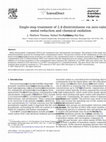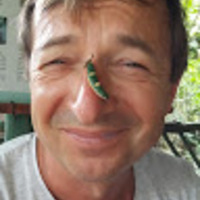Papers by Rafael Hernandez

An active research area on the sustainable production of fuels and chemicals is the use of wastew... more An active research area on the sustainable production of fuels and chemicals is the use of wastewater sludge microorganisms to produce value-added substances. This use of undefined mixed cultures of microorganisms in wastewaters to produce bioenergy materials and other chemicals has been viewed as a new promising technology owing its advantages to lesser operating costs and more stability of the microbial systems involved as compared to using pure microbial cultures. One of the target products is biocrude oil (or biodiesel from microbes), which can be produced from the transesterification of microorganisms with high lipid content. It has been shown that return activated sludge (RAS) from wastewater plants can accumulate high lipid content by feeding on media with high carbon to nitrogen ratio using glucose and xylose as the carbon sources under aerobic incubation. The commercialization of the aerobic lipid accumulation by sludge, however, is challenged by the relatively high cost of...

ABSTRACT There are many chemical and physical processes available for the removal of organic comp... more ABSTRACT There are many chemical and physical processes available for the removal of organic compounds from waste waters. To enhance the sustainability, energy efficiency, and yield of biofuel production processes it is desirable to recover and use these compounds using renewable raw materials. In this study we have used a plant material, Kenaf (Hibiscus cannabinus) for adsorption of small molecular weight phenolic compounds and poly aromatic hydrocarbons generated during the pyrolysis of biomass and contained in the waste water stream. Several pre-treatments of Kenaf were evaluated ranging from simple water washing to Ozone treatment or torrefaction. Torrefaction is gaining attention as an option to improve physical properties of physical and chemical properties of biomass prior to pyrolysis or gasification. This process could also increase the surface area, porosity and selectivity of biomass for adsorption applications. Kenaf was heated slowly in a reduced environment to a maximum temperature of approximately 200 - 300°C. This process can be considered a mild pyrolysis as it occurs at lower temperatures than normal pyrolysis process. The result of torrefaction of Kenaf are compared to other pre-treatments (e,g, ozonation, and washing). Carbon black was used as a positive control, since it is a commercially established adsorption technology and can remove up to 98% of phenol from waste water. Comparisons are based on mass reduction of organics in the waste water The resulting organic laden-Kenaf could be used within the pyrolysis process as an additional feedstock, resulting in a close system for wastewater treatment and an enhanced yield of fuels from biomass.

ABSTRACT Alternatives to petroleum fuels have gained in importance as populations have become inc... more ABSTRACT Alternatives to petroleum fuels have gained in importance as populations have become increasingly aware of the environmental and national security consequences of their use. However, the alternatives currently used in the United States have been shown not to be sustainable because of their food uses. Although lignocellulosic ethanol has promise, it would require a significant amount of freshwater to produce. MSU has been investigating ways to convert wastewater treatment facilities into biorefineries because of the existing infrastructure and plethora of wastewater produced daily (35 b gal). Since the US utilizes an aerobic treatment process ethanol is could not be produced from this process, however ethanol is not the only byproduct from sugar metabolism. A group of microorganisms termed oleaginous have the ability to convert both the pentoses and hexoses to triglycerides and store as much as 70% of their dry weight in this product. The research at MSU has shown these oleaginous microorganisms to utilize all of the lignocellulosic sugars in the presences of furfural and acetic acid and accumulate as much as 45% of their dry weight in lipids. Additionally this work has also shown that a consortium of oleaginous microorganisms can be cultivated in municipal wastewater thereby eliminating the need for freshwater inputs. A parallel set of experiments also has shown the ability of the microbes contained in wastewater to accumulate lipids. These experiments have shown return activated sludge increasing in lipid content from ~6% to ~20% with the addition of lignocellulosic sugars. The advantage this process has over currently investigated processes is the ability to utilize all the lignocellulosic sugars without genetic modification while being carried out in existing infrastructure. This process has the potential to generate greater than 5 billion gallons of a renewable or biodiesel feedstock in the US alone.

J High Energy Phys, 2006
Supergravity backgrounds dual to a class of exactly marginal deformations of Script N = 4 supersy... more Supergravity backgrounds dual to a class of exactly marginal deformations of Script N = 4 supersymmetric Yang-Mills can be constructed through an SL(2,Bbb R) sequence of T-dualities and coordinate shifts. We apply this transformation to multicenter solutions and derive supergravity backgrounds describing the Coulomb branch of Script N = 1 theories at strong 't Hooft coupling as marginal deformations of Script N = 4 Yang-Mills. For concreteness we concentrate to cases with an SO(4) × SO(2) symmetry preserved by continuous distributions of D3-branes on a disc and on a three-dimensional spherical shell. We compute the expectation value of the Wilson loop operator and confirm the Coulombic behaviour of the heavy quark-antiquark potential in the conformal case. When the vev is turned on we find situations where a complete screening of the potential arises, as well as a confining regime where a linear or a logarithmic potential prevails depending on the ratio of the quark-antiquark separation to the typical vev scale. The spectra of massless excitations on these backgrounds are analyzed by turning the associated differential equations into Schrödinger problems. We find explicit solutions taking into account the entire tower of states related to the reduction of type-IIB supergravity to five dimensions, and hence we go beyond the s-wave approximation that has been considered before for the undeformed case. Arbitrary values of the deformation parameter give rise to the Heun differential equation and the related Inozemtsev integrable system, via a non-standard trigonometric limit as we explicitly demonstrate.
The annual production of activated sludges in the United States ranges from 7 – 8 million tons, w... more The annual production of activated sludges in the United States ranges from 7 – 8 million tons, which are being disposed by land-filling or incineration. These disposal methods are heavily regulated and could create adverse environmental impacts. Activated sludges contain microbial consortiums known to produce lipidic materials and many other organic compounds, which could be used to produce biofuels and specialty chemicals. This study focused on modification of a Parr flow reactor for in situ production of green fuel from activated sludge by fluid-bed catalytic cracking. The modifications include on-line analyses to monitor product formation and reaction completion. The on-line analyses use two gas chromatographs for fixed gases and hydrocarbons.
Environmental Progress, 2006
the study with respect to cyanide removal. Surprisingly low removal of TOC was observed, indicati... more the study with respect to cyanide removal. Surprisingly low removal of TOC was observed, indicating a low potential for hydroxyl radicals to remove the organic fraction from this wastewater. A combination of all the results indicates that the main mechanisms of TOC and cyanide removal are volatilization and photolysis, respectively. The results of the treatability study were used in designing a water treatment system currently in operation at the engine manufacturing facility.
RSC Advances, 2012
Activated sludge contains a microbial population responsible for the biological treatment of wast... more Activated sludge contains a microbial population responsible for the biological treatment of wastewater. This microbial population mostly consists of heterothrophic bacteria which utilize the organic content of the wastewater for growth, either as part of their cellular ...
Physics Letters B, 2002
We develop a systematic approach to G 2 holonomy manifolds with an SU(2) × SU(2) isometry using m... more We develop a systematic approach to G 2 holonomy manifolds with an SU(2) × SU(2) isometry using maximal eight-dimensional gauged supergravity to describe D6-branes wrapped on deformed three-spheres. A quite general metric ansatz that generalizes the celebrated Bryant-Salamon metric involves nine functions. We show that only six of them are the independent ones and derive the general first order system of differential equations that they obey. As a byproduct of our analysis, we generalize the notion of the twist that relates the spin and gauge connections in a way that involves non-trivially the scalar fields.
Physics Letters B, 2004
We explicitly construct a solution of eight-dimensional gauged supergravity representing D6-brane... more We explicitly construct a solution of eight-dimensional gauged supergravity representing D6-branes wrapped on six-cycles inside Calabi-Yau fourfolds. The solution preserves two supercharges and asymptotically is a cone with the coset space SU(2) 4 /U(1) 3 as its base. It is shown to correspond to an M-theory compactification on a Calabi-Yau manifold with SU(5) holonomy and we discuss in detail its geometrical and topological features. We also construct a family of related higher dimensional metrics having SU(n+1) holonomy, which of course have no brane interpretation.
Journal of Molecular Catalysis A: Chemical, 2007
Acid-catalyzed cracking reactions of model compounds, palmitic acid and oleic acid, using trifluo... more Acid-catalyzed cracking reactions of model compounds, palmitic acid and oleic acid, using trifluoromethanesulfonic acid were investigated to determine the extent of products from a Bronsted superacid. No reaction was found with the saturated palmitic acid at neither 25 • C nor 100 • C. However, oleic acid, an unsaturated acid, reacted at 0 • C forming linear and branched saturated fatty acids that were of smaller molecular weight than the starting material. These results suggest the potential of using lipids and fatty acids as feedstocks for the manufacture of transportation fuels.
Journal of Molecular Catalysis A: Chemical, 2009
Heterogeneous catalytic transformation of lipids to transportation fuels offers a unique opportun... more Heterogeneous catalytic transformation of lipids to transportation fuels offers a unique opportunity to provide sustainable energy while utilizing the current petroleum refining infrastructure. The reaction chemistry for the heterogeneous catalytic cracking of unsaturated acylglycerides ...
Journal of Hazardous Materials, 2002
Removal of low levels of organic pollutants can be quite challenging to many water treatment proc... more Removal of low levels of organic pollutants can be quite challenging to many water treatment processes. Ketones, such as acetone, are often found in groundwaters and wastewaters at levels too low for supporting a bioreactor, yet since acetone is so soluble, it does not adsorb onto activated carbon very well, nor does it volatilize from water influent using air stripping. This study was undertaken to evaluate three advanced oxidation processes for their comparative ability to remove acetone from aqueous media. Optimization of the oxidation processes was attempted via adjustments of oxidizer inputs. The results indicated that all of the AOPs tested showed promise for removing acetone from water; however, ozonated systems undergoing UV photolysis achieved the highest rate and extent of treatment observed.

Journal of Hazardous Materials, 2008
Many nitroaromatic compounds (NACs) are considered toxic and potential carcinogens. The purpose o... more Many nitroaromatic compounds (NACs) are considered toxic and potential carcinogens. The purpose of this study was to develop an integrated reductive/oxidative process for treating NACs contaminated waters. The process consists of the combination of zero-valent iron and an ozonation based treatment technique. Corrosion promoters are added to the contaminated water to minimize passivation of the metallic species. Water contaminated with 2,4-dinitrotoluene (DNT) was treated with the integrated process using a recirculated batch reactor. It was demonstrated that addition of corrosion promoters to the contaminated water enhances the reduction of 2,4-DNT with zero-valent iron. The addition of corrosion promoters resulted in 62% decrease in 2,4-DNT concentration to 2,4-diaminotoluene. The data shows that iron reduced the 2,4-DNT and ozone oxidized these products resulting in a 73% removal of TOC and a 96% decrease in 2,4-DNT concentration.









Uploads
Papers by Rafael Hernandez